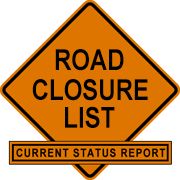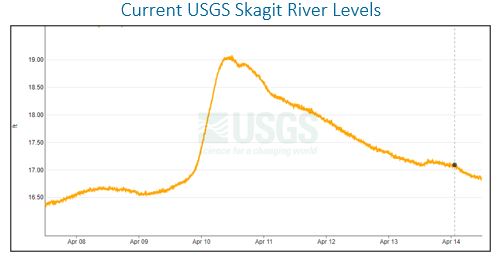|
| |
Flood Preparedness
If we fail to prepare, we are in trouble.
|
|
| |
Need assistance? Call the Department of Emergency Management 360-416-1850
In case of Emergency call 911 |
|
| |
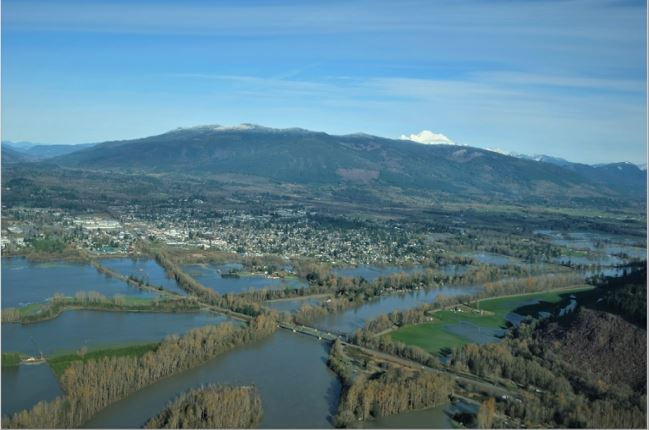 |
|
| |
Floods are one of the most common natural disasters in our area. The Skagit River can experience flooding due to heavy rain, snowmelt, coastal storms, and other severe weather events. These flooding events can cause damage to our homes, close roads ( I-5, State route 9, 20 and 536 all lie in the flood plain), and municipal infrastructure like public drinking water and waste water treatment. The more we are aware of the potential dangers, the better we can prepare and stay safe during a flood event. |
|
| |
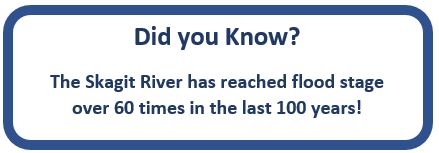
|
|
| |
|
FLOOD WATCH: The first of two basic advisories issued by the National Weather Service. A flood watch is issued when conditions are favorable for flooding. A watch does not mean that flooding will occur, but it does give a community an early notice of potential flooding and allows the community to review flood safety steps.
FLOOD ADVISORY: When flooding is expected to be severe enough to issue a warning. Flooding may occur and cause significant inconvenience. If caution is not exercised, flooding could lead to threats to life and/or property.
FLOOD WARNING: A flood warning is issued when flooding conditions are imminent or in progress so that residents can prepare and take action. Tune to your local emergency alert system to find out if you need to evacuate.
FLOOD STAGE: A site-specific river level at which flood damage may start to occur; usually at or above the top of the riverbank. Flood heights are often measured relative to the flood stage elevation. At the Concrete and Mount Vernon gauges, flood stage is 28 feet.
PHASE 3 FLOODING: Phase 3 floods inundate low areas near the Skagit River, may cover sections of roads, and occur roughly every few years. They generally cause minimal damage in the Skagit River Valley.
PHASE 2 FLOODING: Phase 2 floods inundate a wider area and may cause significant damage. Phase 2 flooding occurred in 2018, 2016, and 2015, when the Skagit River reached heights above 32 feet on the flood gauge in Concrete.
PHASE 1 FLOODING: Phase 1 floods can cause catastrophic damage in the valley. A very large phase 1 flood would be considered a 100-year flood which means the probability of a flood of this magnitude would have approximately a 1% chance of occurring in any given year.
The last Phase 1 flood occurred in November 2021 when the Skagit River reached a height of 38.93 feet on the flood gauge in Concrete.
|
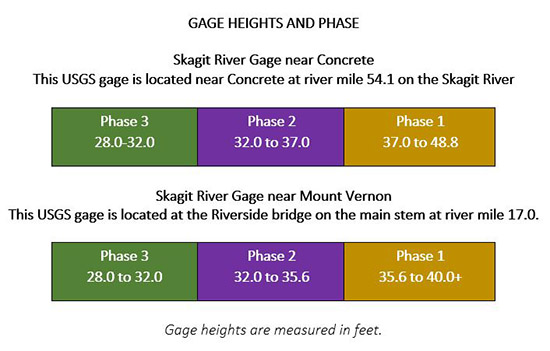 |
100-YEAR FLOOD: A term used to define an extreme flow rate that has a one percent chance of being exceeded in any given year. The 100-year flood is a flood that is equaled or exceeded once every 100 years on average or there is a 1% chance of this flood happening in a given year.
cfs: (cubic feet per second) The rate of flow past a given point. One cubic foot of water equals about 7 gallons.
DIKE DISTRICTS: These districts are given responsibility over the dikes and levees in Skagit County. These districts can assess those within the district that are receiving benefits as well as petition the county, state, and federal government for funding and assistance. Funds raised are used to construct and maintain dikes, levees, tide gates, keyways, and bank stabilization. These districts are administered by a board of commissioners which are elected but do not receive a salary.
For Dike District information call Skagit County Surface Water Management at
(360) 416-1400 |
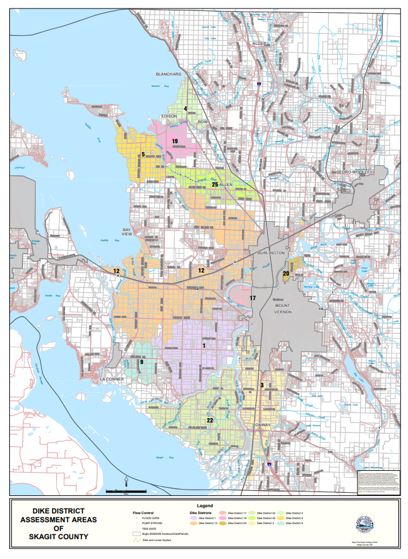
View Skagit County Dike District Map
|
FLOOD INSURANCE: The insurance coverage provided through the National Flood Insurance Program.
Flood Insurance Rate Map (FIRM): An official map of a community on which the Federal Emergency Management Agency has delineated both the special hazard areas and the risk premium zoned applicable to the community. FIRMs typically identify the elevation of the one percent annual chance flood and the areas that would be inundated by that level of flooding; they are used to determine flood insurance rates and for floodplain management. FIRM maps are available at the Skagit County Planning and Permit Center. |
|
|
|
|
A flood watch is issued when conditions are favorable for flooding. It does not mean flooding WILL occur, but it is possible. It provides early notice of potential flooding so the community can prepare.
What to do during a flood watch:
- Know your emergency plan. Where will you go? How will you get there? Don’t forget about your pets, livestock and other loved ones.
- Check and restock your kit. Make sure you have at least two weeks of food and water for everyone in your home (including pets), as well as flashlights and batteries.
- Sign up for alerts. Timely local Weather alerts and warnings can help you make smart decisions.
|
Code RED Emergency Alerts sign up
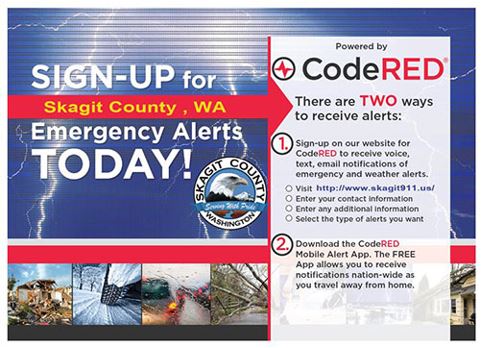
|
|
|
A flood Advisory is issued when flooding isn’t expected to be severe enough to issue a warning. Flooding may occur and cause significant inconvenience. If caution is not exercised, flooding could lead to threats to life and/ or property.
What to do during a flood advisory:
- Stay informed. Turn on your tv, radio, and follow social media for the latest updates and instructions.
- Know where to go. You may need to reach high ground quickly and on foot. Make sure you know your primary and backup evacuation routes.
- Prepare your home. Bring in outdoor furniture and move important items to elevated areas. Do not shelter in attics.
- Prepare your pets and livestock for evacuation.
|
|
|
A flood warning is issued when flooding conditions are imminent or in progress. Tune in to your local emergency alert systems to find out if you need to evacuate.
What to do in case of a flood warning:
- Take immediate action. Evacuate if directed or move to higher ground. Be sure to turn off electricity, water, and gas before evacuating.
- TURN AROUND, DON’T DROWN. Even small amounts of moving water can sweep people and vehicles away. Low lying roads and bridges can also be swept away by flood waters. If floodwaters rise around your car, but the water is not moving, abandon the car and move to high ground.
- Avoid bridges. Fast-moving water can weaken bridge footings making the structure.
|
|
|
- Let friends and family know you are safe.
- Return home when authorities say it is safe to do so.
- Before entering your home, check around for signs of structural damage like foundation issues or gaps around doors or windows. Look through your window to make sure it is safe to enter.
- Inventory Damage
- Contact your insurance agent or insurer as soon as possible to file a claim.
- Call Skagit County Planning and Development Services at (360)416-1320 to arrange a post-damage assessment.
Department of Emergency Management: Initial Damage Assessment forms
- FEMA and/or your insurance company may require an assessment. Skagit County inspectors will visit the site to:
- Inspect the structure.
- Document damage.
- Determine the highest water level that was in the building.
- Classify damage as minor, major, or destroyed.
- Photograph damage to your property. Do what you can to prevent further damage, like putting a tarp over a damaged roof.
- Dispose of any food that has come into contact with flood water and perishable food that has not been properly refrigerated or frozen.
- The red Cross may provide you with vouchers for essentials like groceries, medication, clothing, and a flood clean up kit.
- Check your water source. DO NOT turn water back on until the well has been assessed and or repaired.
- Continue listening to local new for updated information.
- Beware of areas where floodwaters have receded and watch out for debris on or near the road. Road closures and cautionary signs are put in place for your safety. Pay attention to them and do not drive around barricades.
PUBLIC RESOURCES AVAILABLE FOLLOWING A DISASTER
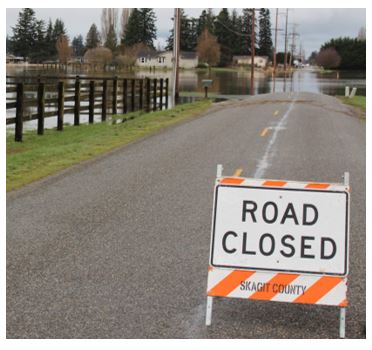
|
|
|
|
- Stay out of flood waters. Flood waters pick up everything in their path including debris and harmful bacteria.
- Chlorinate or boil all water for drinking and food preparation. Use safe food preparation techniques.
- Promote hygienic practices. Masks and cleaning supplies should be stocked in your flood kit.
- Have a stocked first aid kit available in case of injury. Tend to injuries immediately.
- Be aware of electrical hazards.
Health Safety for your home:
- Protect your water source: flood waters can pollute wells, be sure to contact Skagit County Public Health for information regarding residential well testing.
- Mold and indoor air quality: If flood waters entered your home, you may be at risk for mold. Reduce the risk by:
- Remove as much standing water as possible.
- Air out your home by opening windows, closets, doors, attic, eaves, and other vents.
- Warm the house at least 15 degrees higher than the outside temperature.
- Remove baseboards and drill/punch holes in the wall 2 inches above the floor to dry areas between the walls.
- Avoid Carbon Monoxide Poisoning: use alternative sources of fuel for heating, cooking, and electricity.
- DO NOT use propane heaters, generators, or gas ranges indoors.
- Have a battery-operated Carbon Monoxide detector in your home.
- Call 911 and promptly go outside if you have a headache, dizziness, weakness, nausea/vomiting, chest pain, and/ or confusion.
- Be Septic Smart: your system may not function properly after a flood. Minimize water use until floodwaters completely recede and do not use if not toilets and sinks do not drain properly.
- Properly dispose of waste. Flood damaged food, carpets, furniture and any other flood debris should be properly removed and disposed of. Skagit County will provide disposal information as soon as possible.
|
|
|
|
|
|
|
|
|
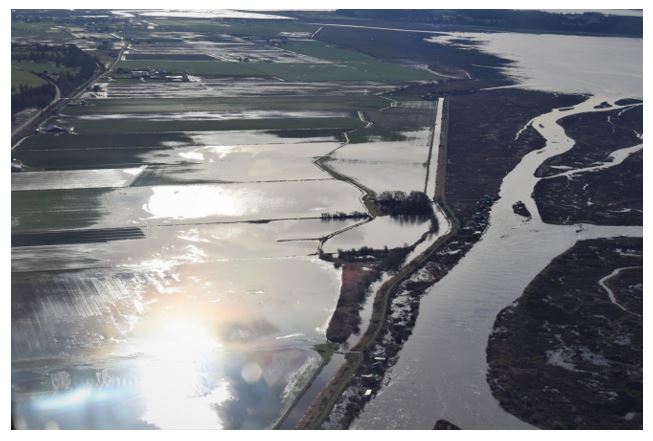
|
|
|
| |
|
|
| |
|
|
| |
|
|
| |
|
|
|
|


